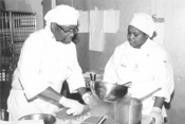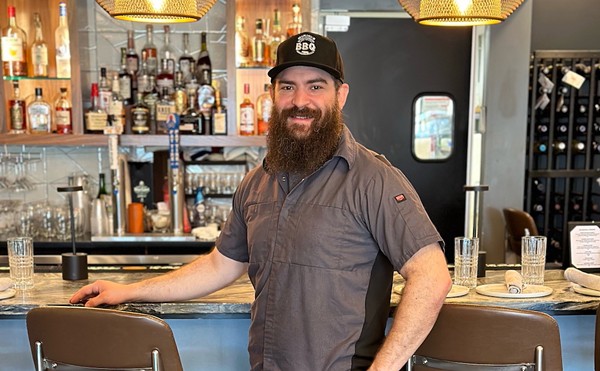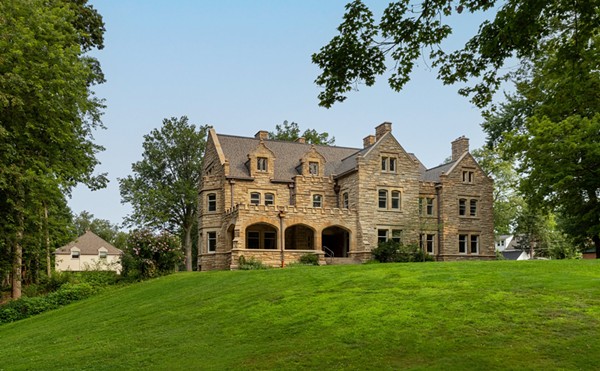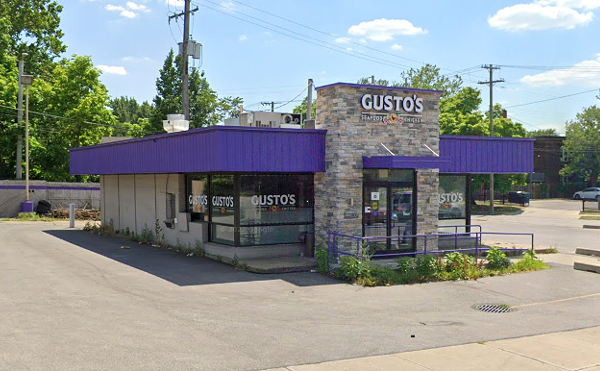Gaw, executive chef at the Watermark restaurant in the Flats, looks over the plates that she and colleague Helen Merkle have just finished picking apart in Bistro 87, the little restaurant/classroom on Cuyahoga Community College's metro campus. She minces no words. "Many of your dishes were almost there. You just needed to add a little salt and pepper, and that would have taken them to the top."
It's almost 2 p.m. on a recent Tuesday, and Gaw and Merkle, a professional chef for the Westfield Companies, are completing a process that began almost eight hours earlier, when four student chefs and their helpers started drifting into the Culinary Arts program's professional kitchen.
The program, part of the school's Hospitality Management Department, offers an associate of applied business degree with a focus on culinary arts. It has become a major source of trained culinary professionals for the Cleveland restaurant industry. Probably its best-known graduate to date is Gaw, a certified executive chef and president of the Cleveland Chapter of the American Culinary Federation. But the list of area employers eager to hire the students is long and impressive, and includes most of the city's top restaurants, hotels, and country clubs.
"We don't have any trouble getting our students placed," says program director Jan De Lucia. "In fact, our biggest problem is that students get such good offers before they complete the program, they sometimes don't bother to graduate."
Tri-C chef-educator Richard Fulchiron, a wiry 55-year-old, agrees. "There's been an incredible growth in the Cleveland restaurant industry in the last few years," he says. "We've gone from a European mindset to the development of a real American cuisine, spearheaded by well-trained American chefs."
The four students sweating it out over the stoves on this day are nearing the end of at least two years of culinary training. During the course of this practical exam, they will try to prove -- in front of judges, faculty, and invited family and friends -- that their skills merit a permanent place in the area's commercial kitchens. If they succeed, they will be one step closer to their shared goal of becoming the next generation of star chefs and restaurateurs on the local dining scene. And if they fail, it will be a professional setback as well as a personal humiliation.
Gary Rush, a 24-year-old former chef's assistant, is the first one on the scene, showing up just after 6 a.m. "I'm very nervous," he confides. "I didn't sleep at all last night." A native of Strongsville, Rush didn't have a clear career direction when he graduated from high school, but now he knows that, in five years, he wants to become an executive chef and eventually a chef-owner.
Turns out, indirect career paths aren't unusual in this industry.
Fulchiron -- who likes to be called Chef Richard -- began his career as a trust auditor in San Francisco after returning from the Vietnam War. But "it just didn't feel right," he says. "So one day, I put it all together. I made the jump into cooking 30 years ago and have never looked back. It's been a labor of love."
"I was inclined toward electronics at first," says student Tim Hiser. At 24, the tall, lanky Hiser is completing an apprenticeship at Spring Valley Country Club. He credits family dynamics and a healthy appetite for making him reconsider his original notions. "My dad is diabetic, and most of my mom's cooking was designed to accommodate him. If I wanted something really good to eat, I had to make it myself," he says wistfully. "Then, once I learned my way around the kitchen, this seemed like the right thing to do."
Temprance Huff had once hoped to become a surgical nurse, "but then I got married and started a family, and staying home with them was important." The 36-year-old mother of six ("Let's see . . . they're 16, 14, 13, 12, 10, and 7") decided that, after all those years of cooking for a crowd, it was time to put her skills to commercial use. "I was always in the kitchen anyway," she laughs. "I figured this is where I ought to be."
The fourth student taking his practical today is Jeremy Kavc, who, at 24, holds down part-time jobs at both Curcio's and the Blue Point Grille. For the exam, each is charged with designing a five-course meal for five, following strict guidelines handed down by Fulchiron. While the meals are to follow a set sequence -- appetizer, soup, salad, entrée, and dessert -- the students draw lots to determine the specifics. Both Huff and Rush are assigned to produce a poached fish starter, cream soup, romaine salad, poultry entrée, puréed veggies, rice pilaf, and mousse. For Kavc, it's steamed fish, consommé, warm salad, sautéed veal, green leafy vegetable, grain, and cake or pie. And for Hiser, the lineup is farci (stuffed) fish or shellfish, puréed soup, broiled lamb, root vegetable, brown or wild rice, and custard.
Besides coming up with the recipes (Veal Saltimbocca, say, for Kavc's entrée, or crème brûlée for Hiser's custard), the students must stay within the confines of a $60 budget. They place their product orders with designated purveyors, develop to-do lists for their test-day helpers (for the most part fellow students), and set up a work schedule so that their courses come out of the kitchen and onto the judges' table at about 15-minute intervals.
The nervous Rush buzzes around the kitchen like an out-of-control blender, toting his supplies from the cooler to his workstation and rounding up his pots and pans. Adding to his anxiety, his helper, Kyle Mahnen, hasn't shown up. "Have you called him?" Chef Richard inquires. "No," Rush replies, his pupils dilated like a deer in headlights. Later, it is suggested that this is payback time. "Gary was two hours late when he was supposed to be helping Kyle during his practical," someone lets slip. When Mahnen finally strolls in at 7:30, he is unapologetic. Was this, in fact, revenge? "Nah," he smiles innocently. "I just like to sleep late."
Huff, meanwhile, is puttering around with her helper, Tony Middlebrooks, a comfy-looking 49-year-old, whose five-course meal earned him top ranking during his own practical exam. "I feel pretty confident about all this," says the unflappable Huff, who, after years of cooking for her own brood, could certainly be forgiven for thinking this is much ado about nothing. Her menu is a lovely Southern-inspired confluence of flavors that she has supplemented by whipping up a completely optional batch of yeast bread and gallons of sweetened iced tea. "This is my chance to give everyone a real taste of Southern hospitality," she says.
By 8, Merkle and Gaw are on the scene. They start by strolling through the kitchen, peering at the students' workstations for signs of proper organization and sanitation. "I don't want to put any extra pressure on them," Gaw explains when the women finally retreat to the dining room to review the students' menus and cost sheets. "I want them to have a chance to get comfortable with us." The two will return to the kitchen frequently during the next three hours, always without fanfare or pretense, to observe, ask questions, and jot down notes.
Hiser, standing over his workstation, has the hands of a potter -- long, slender, and remarkably delicate. By 9, those hands are deftly assembling five portions of poached sole roulade: slender white filets wrapped around a creamy filling of puréed scallop. Next to him, Rush removes a roasted eggplant from one of several ovens, preparing to use it as part of the filling for his entrée: pan-seared stuffed chicken breast. Huff is at her station, concentrating on her cream soup, a golden carrot and roasted red pepper creation.
Between the ovens, four gas ranges, and what must be at least a dozen steaming pots and pans, the temperature in the coolest part of the kitchen has already reached more than 80 degrees. "That's nothing," the well-tempered Merkle sniffs. "In the summer, you can expect at least 120." At 10, Chef Richard calls for the students' attention, announces the time, and reviews the serving schedule. Gary Rush will be first up, with his appetizer -- cold poached salmon with tomato salsa -- to be served at precisely 11:15 a.m. This will be followed, in three or four minutes, by Huff's poached salmon on rye toast, in a creamy caper-studded mayonnaise. Next will come Hiser's sole roulade, quickly followed by Kavc's steamed salmon with lemon butter and dill. Then onto the next courses, all served in the same order. Of the five portions of each dish, one is to be presented to the judges, and a second is to be displayed on a long banquet table. The others go to three smaller tables set up for friends, family, and faculty members.
Twenty different dishes provide lots of food for thought, and Gaw and Merkle take their time. Is Kavc's beef consommé a bit too cloudy? Is Huff's pineapple and lemon mousse entirely too stiff? What about Hiser's crème brûlée, a well-flavored custard that, regrettably, never quite set up? While none of the dishes is an outright disaster, many of them are bland and underseasoned -- hence Gaw's lecture on the virtues of salt and pepper. On the other hand, there is Huff's beautiful cream soup, which Merkle declares "the best I had," and Kavc's delicious warm salad: a savory setup of Roma tomato, baby mozzarella, and artichoke hearts in balsamic vinaigrette. Hiser's rack of lamb is a winner among the entrées, and for dessert, Rush's chocolate-cinnamon mousse is just about perfect.
In order to pass the practical, students need to pull down at least a 2.0 out of 4 possible points. Besides taste, Gaw and Merkle consider the meal's appearance, balance, serving temperature, and portion size -- here, most students err on the side of excess. "Your customers may be impressed by the big portion sizes," cautions Gaw, "but nobody can eat that much!" Only Hiser, with his country club experience, wins kudos for his reasonable portions; to the generous Huff, the judges say pointedly, "This is a lot of food."
In the end, everyone passes, with the two top rankings going to Hiser -- a 2.96 -- and Huff -- a competitive 2.93. Rush, flushed and panting, announces that he did his best and is now going home to sleep. And Huff, looking not at all surprised, admits everything worked out pretty much as she had figured it would.
Her plans call for putting in a few more years at the downtown Marriott, where she works as a cook, and eventually opening her own restaurant -- a little place featuring classic Southern cuisine. "I want to incorporate all the kids into running the restaurant," she says, "so they can experience the joy of cooking and learn a business from the ground up. That's my dream."
She shakes hands and turns to leave, then stops to call over her shoulder. "It was nice meeting you," she says. "My restaurant doesn't have a name yet, but I'll give you a call when it opens!"










